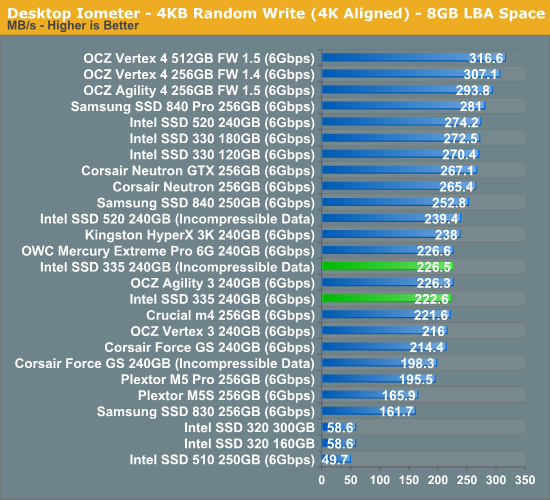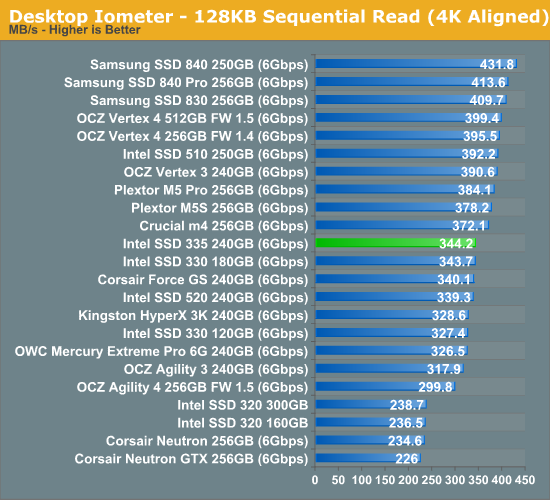Intel SSD 335 (240GB) Review
by Kristian Vättö on October 29, 2012 11:30 AM ESTRandom Read/Write Speed
The four corners of SSD performance are as follows: random read, random write, sequential read and sequential write speed. Random accesses are generally small in size, while sequential accesses tend to be larger and thus we have the four Iometer tests we use in all of our reviews.
Our first test writes 4KB in a completely random pattern over an 8GB space of the drive to simulate the sort of random access that you'd see on an OS drive (even this is more stressful than a normal desktop user would see). I perform three concurrent IOs and run the test for 3 minutes. The results reported are in average MB/s over the entire time. We use both standard pseudo randomly generated data for each write as well as fully random data to show you both the maximum and minimum performance offered by SandForce based drives in these tests. The average performance of SF drives will likely be somewhere in between the two values for each drive you see in the graphs. For an understanding of why this matters, read our original SandForce article.

Random read performance has never been SandForce's biggest strength and even Intel couldn't massively improve it with its own firmware. The SSD 335 is in fact slower than the SSD 330 here.


Random write speed at small queue depths is also slower compared to the 520 and 330, although at queue depth of 32 the difference is negligible.
Sequential Read/Write Speed
To measure sequential performance I ran a 1 minute long 128KB sequential test over the entire span of the drive at a queue depth of 1. The results reported are in average MB/s over the entire test length.


Sequential read performance is identical to SSD 330, but sequential write speed is slightly slower. What's notable is sequential write performance with incompressible data: the Intel SSD 335 manages to beat both the 520 and Corsair's Force GS by a noticeable margin.










69 Comments
View All Comments
Dug - Monday, October 29, 2012 - link
If Samsung continues to produce the 830 as a value drive compared to the 840, I think Intel will have trouble selling these. I don't see any advantage.Kristian Vättö - Monday, October 29, 2012 - link
Samsung is phasing out the SSD 830 by the end of November, so it won't be available much longer.mfenn - Monday, October 29, 2012 - link
Nooooooooo....I want my cheap fast drives damnit!
DanNeely - Monday, October 29, 2012 - link
They're only cheap now to get rid of them; once they're out of the channel people can't point to the old model discount for why the new one is too expensive.If you want a bigger SSD, now's the time to buy the 830 you've been lusting over.
BrianDustin - Tuesday, October 30, 2012 - link
Love my job, since I've been bringing in $5600… I sit at home, music playing while I work in front of my new iMac that I got now that I'm making it online(Click on menu Home)http://goo.gl/ntYAX
JohnUSA - Tuesday, October 30, 2012 - link
You can shove your iMac in your rear where the sun does not shine.jwilliams4200 - Thursday, November 1, 2012 - link
It is too bad the comments software does not have a "report spam" button.JonnyDough - Friday, November 23, 2012 - link
AGREED. :( MODERATOR HELP!hrga - Thursday, November 1, 2012 - link
@BrianDustin SPAMMERWolfpup - Monday, October 29, 2012 - link
Samsung's drivers are flaky if hit hard, and of course less reliable. These Intel drives with Sandforce controllers aren't as good as Intel controllers, but still...Micron/Crucial and Intel are the best choices.